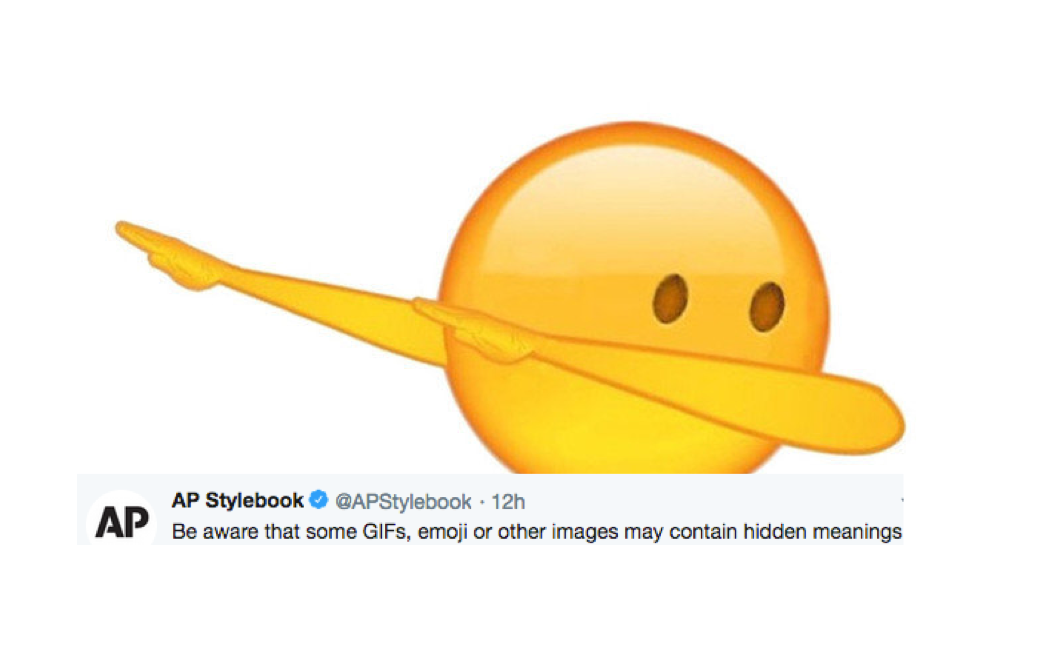Heads-up, dear writers, reporters, editors, content creators, social media specialists, or just about anyone who use emoji professionally (it’s a thing now): the plural of emoji is…emoji.
The new announcement was made official last May 30 in a series of tweet updates made by the verified AP Stylebook Twitter account:
We now use “emoji” for the plural, rather than “emojis.” (1/7) #APStyleChat
— APStylebook (@APStylebook) May 30, 2018
They also have new guidelines for quoting emoji and GIFs (we didn’t even know that this was possible, until now), and other aspects of general usage:
How you quote emoji or GIFs? Treat the visual material in emoji or GIFs as context or gestures when important to include. Describe them by paraphrasing. (2/7) #APStyleChat
— APStylebook (@APStylebook) May 30, 2018
For example: Chavis sparked a flurry of responses against the airline after tweeting a GIF of large crowds at the gate, with the message “#missinghoneymoon” and an emoji string of a worried smiley, a ring, an hourglass and an umbrella on a beach. (3/7) #APStyleChat
— APStylebook (@APStylebook) May 30, 2018
Be aware that some GIFs, emoji or other images may contain hidden meanings and nuances requiring consideration and more than just a simple description of the image posted. (4/7) #APStyleChat
— APStylebook (@APStylebook) May 30, 2018
Don’t use parentheses to describe an emoji within a direct quote, to avoid confusing readers by making it seem as if the person being quoted wrote out the description in text. (5/7) #APStyleChat
— APStylebook (@APStylebook) May 30, 2018
Many story platforms support displaying posts as they actually appear, or hyperlinking to posts on social networks, giving journalists several options to let readers see material for themselves. (6/7) #APStyleChat
— APStylebook (@APStylebook) May 30, 2018
Also, most social networks allow for direct embedding of such material, and screen captures may also be acceptable if images are displayed in accordance with your newsroom’s visual standards. (7/7) #APStyleChat
— APStylebook (@APStylebook) May 30, 2018
If it’s any use for you as a writer/editor/reporter/content creator/social media specialist/general human being, the latest AP Stylebook update also has guidelines for the use of marijuana and racial identities (biracial, multiracial):
A new entry adds more details on marijuana and medical marijuana. Highlights include a history of marijuana as a loaded word, and expanded explanations of terminology for the plant’s derivatives and pharmaceutical uses, such as cannabinoids. (1/3) #APStyleChat
— APStylebook (@APStylebook) May 30, 2018
The entry also adds "synthetic marijuana" or "imitation marijuana" as acceptable terms for drugs like Spice and K2. (2/3) #APStyleChat
— APStylebook (@APStylebook) May 30, 2018
Our June #APStyleChat will focus on marijuana and medical marijuana. (3/3)
— APStylebook (@APStylebook) May 30, 2018
The terms “biracial” and “multiracial” are acceptable, when clearly relevant, to describe people with more than one racial heritage. Usually the terms are more useful when describing large, diverse groups of people rather than individuals. (1/3) #APStyleChat
— APStylebook (@APStylebook) May 30, 2018
Avoid “mixed-race,” which can carry negative connotations, unless a story subject prefers the term. Be specific if possible, and then use “biracial” for people of two heritages or “multiracial” for those of two or more on later references if needed. (2/3) #APStyleChat
— APStylebook (@APStylebook) May 30, 2018
Examples: “She has an African-American father and a white mother” instead of “She is biracial.” But: “The study of biracial people showed a split in support along gender lines.” (3/3) #APStyleChat
— APStylebook (@APStylebook) May 30, 2018
There you have it. Follow AP Stylebook on Twitter because things keep a-changin’ in the English language.
InqPOP!/VT
Attention, grammar nazis: “irregardless” is a real word
This online dictionary decided to define most commonly used emojis
How a missing comma cost this company a lot of money
Apparently, alcohol can help you speak foreign languages better
Get ready to twist your tongue with this lengthy, age-old poem about the English language



